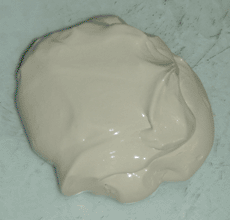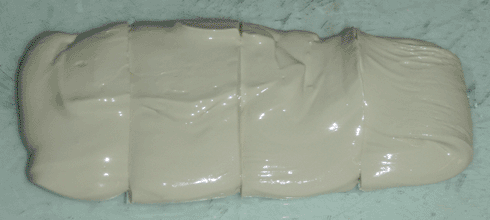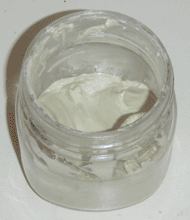


If an oil paint is made using chalk (calcium carbonate) as the pigment, an interesting effect occurs. Rather than being buttery and brushable, the resulting paint is thick, stringy, and viscous. If more chalk is added beyond this point, it eventually loses much of its stickiness and becomes a stiff dough-like material, which can be worked by hand. This is known as putty, and historically it was used extensively for gap-filling and waterproofing, especially in the context of home construction. In modern terms, it takes the place of wood filler, caulk, glazing putty, and plumber's putty, among other things. Having made some on accident while exploring oil paints, I decided to make a batch on purpose to investigate its properties in more detail.
I began by adding 100 grams of chalk to a small mason jar, then adding raw linseed oil while stirring until it became homogeneous. This required about 25 grams of oil, for a 4:1 ratio by weight. I then emptied the jar onto a piece of plate glass and kneaded it with a putty knife, adding chalk until it held its shape and could be handled without any mess. The finished putty can be seen at the top of the page.
The putty behaves interestingly; in general, it can be stretched slowly and torn quickly. This allows it to be cut with a putty knife, but also to slowly conform to wherever it is placed. It is also highly homogeneous, despite the coarse method of mixing. If powdered chalk is worked into the surface, the entire mass rapidly dries out as the oil wets the new material. Likewise, if linseed oil is dropped onto the surface, it quickly becomes fluid.
As a simple test of its utility, I used it to fill a number of small nail-holes on a piece of scrap wood. It quickly lost its oil to the wood and became stiff, but retained its shape and did not turn to dust, indicating that some of the oil remained in the putty. Used in this way, it dries quickly, and could be sanded flush to the wood the next day. I also found that when being applied to a non-porous surface, as is the case in window glazing, it can be slowly pressed into position with the edge of an oiled putty knife, then dusted with chalk so that it holds its shape. Finally, I was also able to use it as a filler in oil paint, to extend the coverage of a more expensive pigment. Overall, this putty appears to be surprisingly versatile for something which began as an accident, and it will be a useful addition to my collection of painting materials.